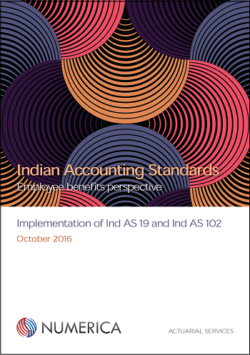
Advanced actuarial services go beyond the usual realm of actuarial reports or statutory certificates. The ability of actuaries to predict future uncertain events and assess their financial impact can help deliver significant benefits to any organisation.
Actuaries are good at making predictions about future uncertain events, and assessing the financial impact of this uncertainty.
As finance leaders would recall, this is an important skill, especially with the growing popularity of ‘risk-based’ or ‘risk-adjusted’ metrics, such as risk-based capital, risk-adjusted earnings, risk-adjusted return on capital etc.
An overview of ‘conventional’ actuarial services in the area of employee benefits is provided here.
Here are four ways in which finance leaders can use advanced actuarial skills to gain tangible benefits:
1. Managing volatility of profit by forecasting employee benefits liabilities
As accounting standards are moving towards a ‘market-based’ approach for measurement of assets and liabilities, the volatility of earnings has increased substantially. Employee benefits liabilities, such as pension and gratuity, are particularly sensitive to changes in market parameters such as interest rates and inflation. They can even drag the entire earnings of the company down.
We maintain a repository of historical discount rates (click here) for actuarial valuation and the level of volatility can be assessed by looking at the historical variations in these rates.
Though the volatility is a direct consequence of what has been prescribed in the accounting standards, companies can ‘prepare’ themselves for this uncertainty. Many companies are surprised at the time of annual year-end reporting due to unexpected movements in benefits liabilities. Companies can go for more frequent interim valuations, but that would consume significant resources.
An easy work around is that the companies can ask their actuaries to project the liability and expense for each quarter or month of the next financial year. These estimates can then be actively revised to allow for any changes in the parameters as we move forward in time over the next financial year. Projection can also include up and down scenarios.
Since these projections will be based on the same data as used for annual actuarial valuation, this exercise is likely to be significantly less onerous compared to a quarterly actuarial valuation. But the benefit from accurate forecasting is likely to be significant.
2. Using asset-liability management to reduce profit volatility
It is known and accepted that recording assets and liabilities on a ‘mark-to-market’ basis inherently creates volatility in financial statements. But this volatility is greatly exacerbated when assets and liabilities of the company are not properly matched.
This issue also manifests primarily for employee benefits liabilities. As an example, if a company is running an unfunded gratuity scheme, a fall in interest rates will lead to a rise in gratuity liability and this will unlimately lead to a reduction in earning by about the same amount. On the other hand, if the liabilities are backed by assets, some of this rise in liability will be offset by a corresponding rise in asset values, thereby diminishing the impact on earnings of the company.
Using ALM techniques, actuaries can construct an asset portfolio that would best match with the liabilites to ensure that returns are maximised subject to an acceptable level of risk.
3. Use actuarial services in designing and costing flexible benefit schemes
This one is perhaps more likely to be of interest to HR leaders. Flexible benefit schemes are gaining popularity around the world. They provide flexibility to employees to choose the benefits that best suit their specific situation. The choices the employees make would be ‘cost-neutral’ to the company as the employees will have to give up some benefits that they consider less useful in order to access the benefits that they want. Its a simple idea that can deliver immense benefits for both the company and employees.
Examples of flexible benefits include:
- Ability to buy additional leaves by giving up part of their fixed salary
- Ability to purchase company shares at a discount to market price in lieu of bonus
- Entitlement to ESOPs in exchange for a long-term incentive
- Diverting a part of their annual bonus towards pension contribution
- Ability to add family members to insurance cover
- Opting for a joint life annuity in retirement instead of a single life annuity
Estimating the cost-neutral terms for the company for each of these benefits is a complicated exercise. For example, how much salary should an employee give up for purchasing an additional leave? Or what should be the exercise price of a stock option so that the employee’s CTC does not increase beyond a pre-determined level? How much annuity should be paid if an employee switches from a single life to a joint life annuity?
Actuaries can set the terms of choosing the benefits in a manner that maximses the utility to employees while maintaining cost-neutrality for the companies.
4. Using actuarial projections in business plans
This is somewhat related to the first point, but instead of focussing just the short-term, actuaries can forecast the employee benefit liabilities, P&L expense and cashflows over a longer period; e.g. 3 to 5 years. These projections can then be combined with business projections to get a more accurate picture of where the business is heading.
Long-term projections can also allow for constructing a schedule of contributions that will maximise the tax benefits. Again, there are tangible financial benefits on offer.
Download our guide for transition to Ind AS: Employee benefits perspective (covering Ind AS 19 and Ind AS 102):


February 12, 2018 at 10:05 pm, Mridul Srivastava said:
Great article! Asset liability management can surely be of great value to our company.
February 16, 2018 at 2:21 pm, Actuarial valuation of gratuity - understanding the sensitivities said:
[…] We also have separate service offerings to address this issue, which you can check out here. […]
March 07, 2018 at 10:16 am, Applicability of actuarial valuation of gratuity scheme • Numerica said:
[…] actuarial valuation of gratuity, leave and pension plans. We have also introduced a range of other non-traditional actuarial services to Indian […]
August 02, 2018 at 10:30 pm, Applicability of actuarial valuation on leave schemes • Numerica said:
[…] actuarial valuation of gratuity, leave and pension plans. We have also introduced a range of other non-traditional actuarial services to Indian […]